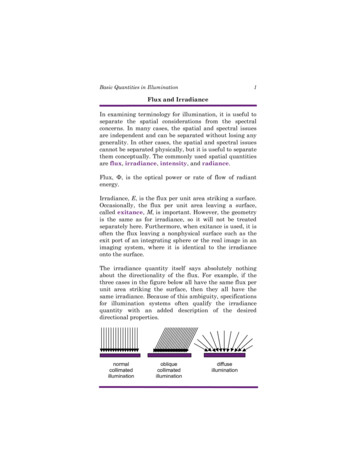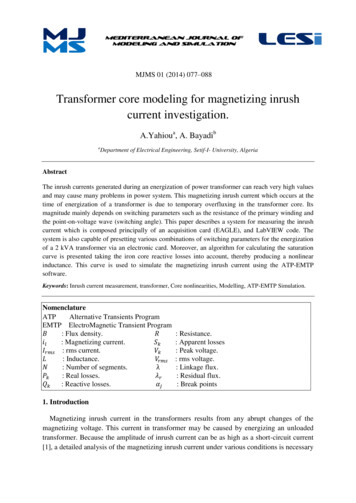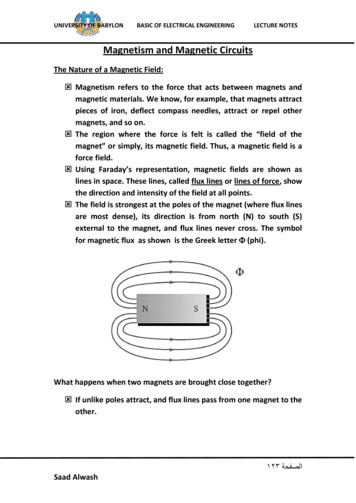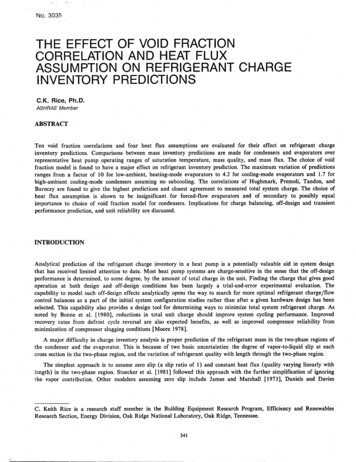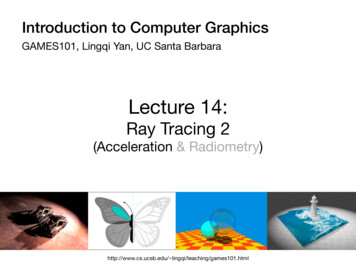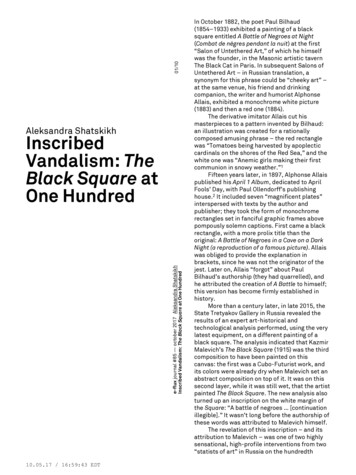
Transcription
01/10Aleksandra Shatskikhe-flux journal #85 Ñ october 2017 Ê Aleksandra ShatskikhInscribed Vandalism: The Black Square at One HundredInscribedVandalism: TheBlack Square atOne Hundred10.05.17 / 16:59:43 EDTIn October 1882, the poet Paul Bilhaud(1854Ð1933) exhibited a painting of a blacksquare entitled A Battle of Negroes at Night(Combat de n gres pendant la nuit) at the firstÒSalon of Untethered Art,Ó of which he himselfwas the founder, in the Masonic artistic tavernThe Black Cat in Paris. In subsequent Salons ofUntethered Art Ð in Russian translation, asynonym for this phrase could be Òcheeky artÓ Ðat the same venue, his friend and drinkingcompanion, the writer and humorist AlphonseAllais, exhibited a monochrome white picture(1883) and then a red one (1884).ÊÊÊÊÊÊÊÊÊÊThe derivative imitator Allais cut hismasterpieces to a pattern invented by Bilhaud:an illustration was created for a rationallycomposed amusing phrase Ð the red rectanglewas ÒTomatoes being harvested by apoplecticcardinals on the shores of the Red Sea,Ó and thewhite one was ÒAnemic girls making their firstcommunion in snowy weather.Ó1ÊÊÊÊÊÊÊÊÊÊFifteen years later, in 1897, Alphonse Allaispublished his April 1 Album, dedicated to AprilFoolsÕ Day, with Paul OllendorffÕs publishinghouse.2 It included seven Òmagnificent platesÓinterspersed with texts by the author andpublisher; they took the form of monochromerectangles set in fanciful graphic frames abovepompously solemn captions. First came a blackrectangle, with a more prolix title than theoriginal: A Battle of Negroes in a Cave on a DarkNight (a reproduction of a famous picture). Allaiswas obliged to provide the explanation inbrackets, since he was not the originator of thejest. Later on, Allais ÒforgotÓ about PaulBilhaudÕs authorship (they had quarrelled), andhe attributed the creation of A Battle to himself;this version has become firmly established inhistory.ÊÊÊÊÊÊÊÊÊÊMore than a century later, in late 2015, theState Tretyakov Gallery in Russia revealed theresults of an expert art-historical andtechnological analysis performed, using the verylatest equipment, on a different painting of ablack square. The analysis indicated that KazmirMalevichÕs The Black Square (1915) was the thirdcomposition to have been painted on thiscanvas: the first was a Cubo-Futurist work, andits colors were already dry when Malevich set anabstract composition on top of it. It was on thissecond layer, while it was still wet, that the artistpainted The Black Square. The new analysis alsoturned up an inscription on the white margin ofthe Square: ÒA battle of negroes É [continuationillegible].Ó It wasnÕt long before the authorship ofthese words was attributed to Malevich himself.ÊÊÊÊÊÊÊÊÊÊThe revelation of this inscription Ð and itsattribution to Malevich Ð was one of two highlysensational, high-profile interventions from twoÒstatists of artÓ in Russia on the hundredth
02/1010.05.17 / 16:59:43 EDT
03/10anniversary year of 1915. I am borrowing thisterm Òstatists of artÓ from Malevich himself: itwas how the artist defined people who, beingunquestioningly convinced of the correctness oftheir own pronouncements and holding positionsof power, determined Òtruths in artÓ according totheir own ÒcorrectÓ notions.3ÊÊÊÊÊÊÊÊÊÊThe first of these Russian Òpillars of thestateÓ to comment on the anniversary of TheBlack Square was the Patriarch Kirill, who isendowed with supreme Òspiritual authorityÓ inpresent-day Russia, where the current situationis one of the coalescence of the Orthodox Churchand the state. The declaration by the paramountpastor of millions of Russians, made in thecourse of an address to the EpiscopalConference on February 2, 2015, was widelybroadcast in the mass media:In the context of the speech given by the overlordof the Orthodox Church, it emerges that the soulof Òthis MalevichÓ was black and terrifying, andfor ÒusÓ (read: Òthe flock of the irreproachablyvirtuous patriarchÓ), the only salvation from thebaneful scourge symbolized by The Black Squareis to unite around its complete opposite, theVladimir Icon of the Mother of God.ÊÊÊÊÊÊÊÊÊÊAccusations that Malevich and his mostimportant work, The Black Square, present uswith Òpure evil,Ó Òdarkness,Ó and Òthe devilÕsworkÓ are by no means new; they have beenconstant companions of the pictureÕs existencesince its appearance in 1915. The approachtaken by the statists of the Soviet Union waseven more thoroughgoing; they quite simplydeleted both the picture and the artistÕs namefrom the history of art. In post-Soviet Russia, thestatist artist Ilya Glazunov and the writer TatyanaTolstaya have piled on the black tones in theirfulminations against The Black Square, andmodern Russian realist artists continue to denythe picture any place in art, seeing it as Òa trick,ÓÒa stunt,Ó and Òa contemptuous fraud.ÓÊÊÊÊÊÊÊÊÊÊIn view of the multivalent and expansivenature of the phenomenon that is known as TheBlack Square, such accusations merely tell usthat even now this picture is capable of10.05.17 / 16:59:43 EDTe-flux journal #85 Ñ october 2017 Ê Aleksandra ShatskikhInscribed Vandalism: The Black Square at One HundredI acknowledge the place of Malevich andhis Black Square in Russian art, becausethis terrifying, so to speak, black square isa genuine reflection of what was in the soulof this Malevich. And it reflects not onlyMalevich, it reflects the spirit of the age.And in order to understand what ishappening to us, take the Vladimir Icon ofthe Mother of God and MalevichÕs BlackSquare, and you will not need any morescriptures, or treatises, or proofs Ð you willsee what has happened to humankind.provoking a phenomenally lively reaction: TheBlack Square is alive, it continues to live andretains its relevance a century after it wascreated Ð there is no other example of this kindin the history of world art.ÊÊÊÊÊÊÊÊÊÊThe anniversary year began with theorientational statement from Patriarch Kirill, andtowards its end, in October 2015, the StateTretyakov Gallery, the main museum of Russianart, where the Òicon of our timeÓ (MalevichÕswords) is kept, made its own stunning andsensational pronouncement.ÊÊÊÊÊÊÊÊÊÊThe sensation was initially made public onOctober 3, 2015 in a talk given by the director ofthe Tretyakov Gallery, Z. I. Tregulova, at theopening of the exhibition Ò0.10Ó at the BeyerFoundation in Basel.4 Later, the gallery directorheld a press conference in Moscow, invitingreporters into the hall where The Black Squarewas hanging. According to Tregulova, the crowdof journalists there was equal only to the numberusually seen at one of President PutinÕs pressconferences.5ÊÊÊÊÊÊÊÊÊÊAt the press conference, the results wereannounced of the new expert art-historical andtechnological analysis carried out on The BlackSquare.6 By virtue of historical circumstance andnational mentality, Russians prefer whendecisions, conclusions, and politics areÒcollectiveÓ; this testifies to the ÒobjectivityÓ andÒveracityÓ of what is determined and proclaimedby the collective (commune, committee, party,team, etc.). The conclusions of the newinvestigations were not announced in the nameof the individual researchers, but in the name ofthe collective of the State Tretyakov Gallery, thatis, in the name of Òstate employees.Ó7 The factthat The Black Square of 1915 is overlaid onanother picture has been known for a very longtime: pinkish-red, yellow, and blue elements areclearly visible through the crack patterns of thepicture. An x-ray of the picture that documentedthe underlying composition was published in1991.8 There was nothing sensational about thisÐ the stunning sensation was provided bysomething else. In order not to misrepresent inthe least the conclusions that were reached bythe staff members of the Tretyakov Gallery, Iquote at length from I. A. VakarÕs book:On the white margin of the Square theremains of an inscription by the artist werediscovered. It could be read as ÒA battle ofnegroes,Ó followed by an indecipherableword (what it is can only be surmised on thebasis of the context: in darkness (?) in acave (?) at night (?).[9] The inscription, madein pencil on the dry paint, was either lostwith the passage of time or erased by theartist. There are two possible explanations
ÒA one-hour-long exhibition parodying theÔWorld of ArtÕ has been held by youngartists from AzhViZ [the Academy ofPainting, Sculpture and Architecture].ÒIn imitation of the latest forms of theÔSalon des Beaux ArtsÕ Ð in LarionovÕs oneday exhibition Ð the young artists organizeda Ôone-hourÕ exhibition. In first place stoodthe panel A Battle of Negroes at Night: ablack-ink poster with white spots Ð thestars and the eyes of the negro fighters.Ó[10]In either case, MalevichÕs first reaction tothe birth of his Òregal infantÓ comes as acomplete surprise. After his profound10.05.17 / 16:59:43 EDTdeliberations, trials, and searches, theauthor seems to ask himself: But is it apicture? Can it be taken seriously?04/10for this phrase. Possibly Malevich knew ofthe existence of a painting by the famousjoker Alphonse Allais (1854Ð1905), A Battleof Negroes in a Cave in the Middle of theNight (1893), which represented a blackrectangle, and he was hinting at that work.Or perhaps he recalled an amusing episodethat was reported in the newspaper TheRussian Word (Russkoe Slovo) in December,1911:We are used to accepting Malevich with hismysterious Squares, prophetic Òwritings,Óand pompous manner of behaving like anindividual full of gravity and high pathos.This was the attitude that Malevich used toinspire his students, and in time it wasautomatically transmitted to historians ofart. However, it is somehow forgotten thathe possessed a rare sense of humor andloved pranks and jokes; precisely duringthe Futurist period, and afterwards in theperiod of Alogism and Februarism,Malevich was completely immersed in aludic, humorous environment. Hisfascination with the absurd facilitated hisfriendship with the poet Kruchenykh; inJune and early July, after the Square hadalready been created, the artist wrote a textfor the poetÕs publication that concludedwith the words: ÒOf course, many peoplewill think that this is absurd, butmistakenly so, one only has to light twomatches and put in a wash-basin.Ó
05/10In Alogism, Malevich made active use of theword, including it in his drawings Ð let usrecall the previously mentioned black andwhite sketch for Victory over the Sun:ÒStupid.Ó Sometimes the imagedisappeared completely, giving way to aframed text (ÒA Fight on the Avenue,Ó ÒAVillageÓ). There are also nonrepresentational drawings (including somewith squares) accompanied by inscriptions.Thus we can draw the conclusion thatMalevich needed time to realize the scale ofhis discovery. In two letters in June, therealization has already taken place ÐMalevich formulates the most importantthing that constitutes the meaning andsignificance of his picture É And what ismore, Òmaterial is building upÓ for hisfuture brochure From Cubism toSuprematism (which, according to theauthorÕs date, was completed in June).Ó11In this extensive passage on the appearance ofthe Òanti-pictureÓ that is MalevichÕs major workand his understanding of it, every point is worthyof comment: here we have an eminent arthistorian, who has devoted many years toresearching MalevichÕs art, vividly demonstratingher understanding of both the artistÕs personalityand his discoveries.ÊÊÊÊÊÊÊÊÊÊVakar emphasizes that she is offering herown Òauthorial versionÓ of the inscription. At theend of the book, in the Appendix, the collective ofthe State Tretyakov Gallery offers its owninterpretation in the form of an unqualifiedassertion:In one of the margins a partially lostinscription by the artist was discovered. Ithad been written in black pencil on thealready dry layer of white paint andconsists of several words.10.05.17 / 16:59:43 EDTe-flux journal #85 Ñ october 2017 Ê Aleksandra ShatskikhInscribed Vandalism: The Black Square at One HundredThus the genesis of the Square becomesclearer Ð this anti-picture turns out to beclosely connected with the preceding stageof the artistÕs creative evolution. But theessential novelty of The Black Square wentbeyond its inherited features, and Malevichcould not fail to understand that. If hehimself removed the inscription from theSquare, it was no accident: in Suprematismthe word is banished from the picturesurface. An inscription on the front of apicture is impermissible here, as are thedate, letters and numbers typical of CuboFuturism.Separate letters can be read visually. Whenletters were reconstructed from theirfragments using a binocular microscope,the first two words were read as ÒB[a] tle ne[r?v?].Ó[12] As a result of visual comparisonof the letters in the inscription that hadbeen discovered with the artistÕsinscriptions on genuine pictures byMalevich in the collection of the TretyakovGallery, we [the collective of the TretyakovGallery] came to the conclusion that it wasmade by the artistÕs own hand. The positionof the inscription that was discoveredmakes it possible to suppose that thismargin is the lower section of the picture,and this position of The Black Square is theone that the artist intended.Ó13During a discussion in New York that followed myquestion about whether the Tretyakovresearchers had consulted graphologists, Vakarreplied that their opinions never coincided Ðwhich meant that the collective had not availeditself of graphological analysis. But let meemphasize that, even if the museum workers hadresorted to it, no conscientious graphologyexpert would have undertaken to statedogmatically that the inscription that had beendiscovered, with a limited number of casuallyjotted-down letters, belonged to Òthe artistÕshandÓ Ð the amount of material is insufficient forany proper conclusion.ÊÊÊÊÊÊÊÊÊÊThe research collective established that thepencil inscription had been made on a drysurface. Vakar and the group of technologiststhat she headed completely failed to pose thequestion of how long is required for a doublelayer of paint to dry out. Let me clarify that thedrying of a single layer of paint is a rather lengthyprocess, especially when it is applied with atextured effect Ð The Black Square is paintedwith a textured surface Ð and a double layer ofpaint requires an even longer period of time. Onereason that the upper layer of the picturecracked is that the drying of the lower and upperimages lasted not just weeks, but years.ÊÊÊÊÊÊÊÊÊÊAfter having painted The Black Square,Malevich Ð in VakarÕs judgement Ð did notunderstand what had happened: ÒThe sense ofpuzzlement immediately experienced by anyonewho encounters the Square was probably firstexperienced by the artist,Ó writes theresearcher.14 The avant-garde artist remained inthis state of ÒpuzzlementÓ for the prolongedperiod of time required for the painting to dry.And only after the surface was firm, and did notcave in under the pencil, did he, Òwonderingwhether this is a picture,Ó write the phrase,
10.05.17 / 16:59:43 EDT06/10having either ÒrecalledÓ a work by the FrenchmanAlphonse Allais, A Battle of Negroes in a Cave atNight, or ÒrespondedÓ to a jolly parody bystudents at the Moscow Academy of Painting,Sculpture, and Architecture, who copied a prankplayed by Parisians Ð let me note that in thiscase he would have had to ÒrecallÓ a newspaperarticle from almost four years earlier, since theÒblack-ink posterÓ existed for only one hour.ÊÊÊÊÊÊÊÊÊÊThe researcher unhesitatingly positions TheBlack Square in this sequence of Òhumorousjokes,Ó since both she and her collective areabsolutely convinced that Malevich is the authorof the inscription ÒA battle of negroes ÉÓ on thefront of the picture. And since the words runalong the left side of the white margin below theblack square, the Tretyakov researchersconfidently establish the ÒcorrectÓ orientation inthe sense of top and bottom, basing their opinionon the ÒauthorialÓ location of the phrase.ÊÊÊÊÊÊÊÊÊÊVakar drew her information about thecreation and existence of the work A Battle ofNegroes in a Cave at Night from the internet,most probably from Wikipedia. Phillip DenisCate, a historian and connoisseur of the cultureof Parisian bohemian taverns, artistic cabarets,and cafŽs chantants, has explained the history ofA Battle far more precisely, providing us withadditional, important details of its biography.15When they declared the inscription on The BlackSquare to be Òauthorial,Ó neither Vakar nor thecollective as a whole felt even a shadow of doubtthat Malevich could have thought of his BlackSquare as a banal illustration and written a titleexplaining its subject in the white margin belowthe black Òillustration.Ó This was precisely theapproach taken by Paul Bilhaud and thenAlphonse Allais: an ÒillustrationÓ and itshumorous title. Allais replicated Paul BilhaudÕsdiscovery, and the jokers at the MoscowAcademy of Painting, Sculpture, and Architecturereplicated the replication Ð permit me to note inpassing that witticisms are only authentic whenfresh; afterwards they become plagiarism andclichŽ.ÊÊÊÊÊÊÊÊÊÊLet me emphasize once again thatÒillustrationsÓ with Ònegroes,Ó Òcardinals,Ó andÒanemic girls,Ó and others of the same ilk, werepublished as a collection by Alphonse Allais in1897 in Paris. If the Tretyakov researchers haddug a bit deeper, they would have been wary oftracing the genesis of The Black Square back to aset of April FoolsÕ Day jokes.ÊÊÊÊÊÊÊÊÊÊBut then, that is not necessarily the case Ðin her book, the leader of the collectivespeculates that The Black Square could havebeen given the title A Battle of Negroes owing toMalevichÕs character as a lover of Òa ludic,humorous environment.Ó In other words,according to Vakar, Malevich could quite easily
10.05.17 / 16:59:43 EDT07/10have supported the rambunctious celebration ofApril FoolsÕ Day. As an illustrative example of theavant-garde artistÕs jolly disposition, sheadduces the celebrated concluding passage ofhis text in the book The Secret Vices ofAcademics.16 And here I would like to pose arhetorical question to the researcher: Does shereally not see any difference between the clichŽdjokes of fun-loving bohemian cafŽ society andthe aesthetic of Alogism and the absurd?ÊÊÊÊÊÊÊÊÊÊAmusement was the primary and supremelyimportant raison dÕ tre of the works of thewisecracking wits and jolly blades whoseplaygrounds were the cafŽ chantants, cabarets,artistic taverns, basements, and humorousjournals of Paris Ð those true procreators ofmass culture, with its fundamental basis ofentertainment with a view to commercialreturns. No one (except perhaps Pavel Filonov)was further from amusing bohemian culture thanKazimir Malevich, for all his attachment to Òaludic, humorous environment.ÓÊÊÊÊÊÊÊÊÊÊIn connection with the birth of The BlackSquare, Vakar cannot avoid mentioning eventsfor which there is documentary confirmation Ðon June 9, 2015, Malevich sends a letter, oldstyle, to Matiushin that includes propositions ofamazing insight in relation to futuremetamorphoses of The Black Square.17 However,with quite extraordinary flippancy, the researcherignores the astonishing inconsistency betweenthese prophetic propositions and her ownassertions that Malevich Òfailed to understandÓ apicture in which, as she envisages things, for along time Ð all the time that the picture took todry Ð he saw A Battle of Negroes.ÊÊÊÊÊÊÊÊÊÊAs an art historian who has spent manyyears studying MalevichÕs life and work, I am wellaware that the artist had a sense of humor, andsometimes he could be a jolly, even resourcefullyjolly, character (I have written repeatedly and indetail about his relations with the ÒOberiutyÓwriters18); however, I would like to emphasizehere that he never borrowed other peopleÕs staleÒhumorous jokes,Ó that is, he was not the banalplagiarist and platitudinous individual that heappears to be, as presented by the statistmuseum workers in the role of the author of theinscription A Battle of Negroes. The journalistswho heard the sensational announcements atthe press conference drew direct and preciseconclusions. I cite the headlines of reports,articles, and comments: ÒOriginal TitleDiscovered Below the Picture Black Square,Ó ÒACentury-Long Joke,Ó ÒThe Black Square WasHanging Upside-Down the Whole Time,Ó ÒARemake of an Old Joke about Negroes,Ó ÒTheBlack Square could be an exquisite act ofplagiarism,Ó and so on.19ÊÊÊÊÊÊÊÊÊÊWhen Z. I. Tregulova, the director of the
10.05.17 / 16:59:43 EDT08/10e-flux journal #85 Ñ october 2017 Ê Aleksandra ShatskikhInscribed Vandalism: The Black Square at One HundredTretyakov Gallery, addressed the foreignaudience at the opening of the exhibition inBasel, she did not explain to them that inRussian the word ÒnegroÓ has never had anddoes not now have a derogatory and insultingmeaning; in the West, the conclusions drawnfrom the sensational ÒauthorialÓ inscriptionfollowed immediately. On the basis of TregulovaÕstalk in Switzerland and the press conference inMoscow, the European and American massmedia and online publications erupted inindignant responses and comments aboutÒracist jokesÓ and Òracist conceptualutterances.Ó20 Placing its complete confidence inthe Russian researchers, the Western public sawMalevich as an individual with racist views.ÊÊÊÊÊÊÊÊÊÊConcerning the orgiastic frenzy that tookplace on the hundredth anniversary of The BlackSquare after the discovery of the sensationalinscription ÒA Battle of Negroes É,Ó I wish toaffirm with absolute conviction that KazimirMalevich had nothing at all to do with it Ð theRussian avant-garde artistÕs most importantpicture was vandalized by some Òjolly and quickwittedÓ individual, who left a graffito on it. Therehave always been, always are, and always will bepeople who wish to debunk, unmask, and ÒsmackdownÓ The Black Square. Some vulgar humoristmanaged to leave his mark and perpetrate anoutrage against the abhorrent Òanti-picture.ÓÊÊÊÊÊÊÊÊÊÊThe State Tretyakov Gallery was clearly intoo much of a rush to present a sensation on thehundredth anniversary year, and therefore thequestion of how The Black Square hung atMalevichÕs first individual exhibition21 or whatposition it occupied in the Moscow Museum ofArtistic Culture was not a matter ofconsideration for them. In the name of fairness,let me say that the answer cannot be foundanyway, but in the name of the same fairness, letme emphasize that in those years it was not atall difficult to gain access to the painting. Whenthe Tretyakov researchers discovered aninscription made on a dry layer of paint, theyshould have borne that in mind.ÊÊÊÊÊÊÊÊÊÊThe researchers also failed to consider thequestion of whether there were any instances ofinscriptions being made on the front of pictures,but not made by Malevich. I would like to informthe reader that there were such instances. It iswell known that the inscription on Compositionwith the Mona Lisa (1915) raised and continuesto raise the question of whether it was made byMalevich himself. However, it is more importantthat there was an inscription in pencil on thefront of the transrational (zaum) pictureReservist of the First Division, which is now inMoMA, New York. The inscription was discoveredin 1991 in the US during technologicalinvestigations in the course of a conferencedevoted to Malevich.22 The inscription wasunambiguously derisive in nature and it waswritten by a hand that was not MalevichÕs.23ÊÊÊÊÊÊÊÊÊÊThe Tretyakov team also remained unawareof the vandalization of a work by V. E. Tatlin,which occurred in early 1915 and was reported inthe press. On January 26, 1915, the Moscownewspaper The Evening News (Vechernieizvestiya) carried an unsigned article entitledÒPicture defaced at exhibition,Ó which describedan incident from two weeks earlier: ÒSomeoneinscribed the word ÔmadmanÕ on TatlinÕs pictureBoyar. It was not established who made theinscription, and when Tatlin called in the policeto draw up a report, the inscription haddisappeared. It emerged that the supervisor ofthe exhibition, Mr. Kreitor, had removed theinscription with an eraser.Ó24ÊÊÊÊÊÊÊÊÊÊI wish to stress the significance of thisoccurrence: some individual acting the hooligansneakily wrote a ÒwittyÓ graffito on the picture,committing an act of vandalism that wasofficially recorded in a newspaper. The outragedTatlin submitted a complaint to a magistrate ofthe peace; since the inscription had already beenerased, the artist decided not to sue thesupervisor of the exhibition and the case wasdropped on the joint request of both parties.25ÊÊÊÊÊÊÊÊÊÊInstances of the aggressive vandalization ofworks of art have occurred over the decades andthe centuries; there is the well-known case ofthe 1997 defacement of one of MalevichÕspictures at the Stedelijk Museum by an ÒactionartistÓ hungry for fame.[footnote However, theculprit, Mr. A. Brener, proved to have calculatedcorrectly: his name will go down in history,although only in the small-print notes to thebiography of MalevichÕs picture White Cross on aWhite Background. The mischievous ÒactionartistÓ spent a long time planning his onlyÒcreative achievement,Ó thoroughly studying theprison terms for vandalism in the US andHolland; in America he would have faceddecades of imprisonment, so he chose Holland,knowing that there he would be given less than ayear for an Òartistic gesture.Ó The desecrator andÊÊÊÊÊÊÊÊÊÊvandal walked free after seven months.] Ahighly sensational case occurred in 2015, wheninsulting inscriptions were written on a sculptureby Anish Kapoor that was exhibited at Versailles.ÊÊÊÊÊÊÊÊÊÊHowever, no one has ever attributed ÒjollyÓor pejorative graffiti to the artist who made thework involved Ð vandalization is just that, thedesecration of an artistÕs work, a bellicosecriticÕs intrusion into the artistÕs creation.ÊÊÊÊÊÊÊÊÊÊIn the case of the notorious sensation thatoccurred in 1915 over the phrase ÒA battle ofnegroes ÉÓ on The Black Square, a uniquesituation has come about: the Tretyakov GalleryÕsresearchers have lent their support to the
Aleksandra Shatskikh is an art historian and a worldauthority on the Russian avant-garde.09/10fabricator of a jeering inscription and officiallydecreed that it was made by MalevichÕs ownhand; that is, they have authoritativelyincorporated it into The Black Square.ÊÊÊÊÊÊÊÊÊÊTo my mind, this act constitutes therepeated vandalization of the Russian avantgarde artistÕs most important picture, this timeby the ÒstatistsÓ of the State Tretyakov Gallery.ÊÊÊÊÊÊÊÊÊÊ e-flux journal #85 Ñ october 2017 Ê Aleksandra ShatskikhInscribed Vandalism: The Black Square at One HundredTranslated from the Russian byÊAndrew Bromfield.All film stills from Immortality and Resurrection For All!Ê(2017)by Anton Vidokle. Video 34Õ.ÊCourtesy of the artist.ÊÊÊÊ10.05.17 / 16:59:43 EDT
ÊÊÊÊÊÊ2Alphonse Allais, Album PrimoAvrilesque (Paris: PaulOllendorff, Žditeur, 1897). Forcolor reproductions, see TheSpirit of Montmartre, colorplates on 8Ð9.ÊÊÊÊÊÊ9VakarÕs note, number 54, to thisphrase: ÒHere I offer my ownauthorial interpretation, adifferent reading is given in theAppendix.ÓÊÊÊÊÊÊ10Note 55 in VakarÕs text gives thefollowing reference: ÒArtisticParodiesÓ hillip Dennis Cate, ÒThe Spiritof Montmartre,Ó in The Spirit ofMontmartre: Cabarets, Humorand the Avant-Garde,1975Ð1905, eds. Phillip DennisCate and Mary Shaw (NewBrunswick, NJ: State Universityof New Jersey Rutgers, 1996),29Ð31.ÊÊÊÊÊÊ11I. A. Vakar, Kazimir Malevich: TheBlack Square (Moscow: TheState Tretyakov Gallery, 2015),24Ð25. All emphasis added.ÊÊÊÊÊÊ3Kazimir Malevich, ÒTo StateBureaucrats of ArtÓ(ÒGosudarstvennikam otiskusstvaÓ), Anarchy (Anarkhiya)53 (1918). Republished inKazimir Malevich, CollectedWorks in Five Volumes (Sobraniesochinenii v pyati tomakh), vol. 1(Moscow: Gilea, 1995), 75Ð87.ÊÊÊÊÊÊ12This is a failure of attention onthe part of the authors or theeditor Ð in this reading theinscription looks like ÒA Battle ofnervesÓ: no comment is madehere on the divergence fromVakarÕs account. (TranslatorÕsnote: There is, of course, onlypartial correspondence betweenÊÊÊÊÊÊ4the putative Russian letters andFor Z. I. TregulovaÕs talk, seethe English rendition here Ð nothttps://www.youtube.com/watcto mention the fact that Russianh?v P5Wcw4SBNQo&feature youtu.be.has no articles.)ÊÊÊÊÊÊ6The investigation was performedby staff of the Tretyakov Gallery,under the leadership of I. A.Vakar, an art historian who hasdevoted many years to studyingMalevichÕs art. The teamincluded members of thedepartment of scientificanalysis: Y. A. Voronina, I. A.Kasatkina, Ye. A. Liubavskaya, A.A. Mareev, and I. V. Rustamova.ÊÊÊÊÊÊ7The new discoveries that wereoutlined at the headline-makingpress conference weredescribed in greater detail in I.A. VakarÕs book The BlackSquare, published by theTretyakov Gallery to mark thepictureÕs hundredth anniversary.I shall base my subsequentcomments in this article on thetext of that book, oralpresentations made byrepresentatives of the gallery inOctober and November 2015,and the paper given by I. A.Vakar at the Malevich Societyconference Ò100 Years ofSuprematism,Ó held at theHarriman Institute in New Yorkon December 11Ð12, 2015,together with the discussionthat developed after it.ÊÊÊÊÊÊ8M. Vikturina and A. Lukanova, ÒAStudy of Technique: TenPaintings by Malevich in theTretiakov Gallery,Ó in KazimirMalevich, 1878Ð1935 (LosAngeles: Hammer Museum ofArt, 1990), 195.ÊÊÊÊÊÊ13Ye. A. Voronina and I. V.Rustamova, ÒResults of atechnological investigation ofThe Black Suprematist Square byK. S. Malevich,Ó in Vakar, KazimirMalevich: The Black Square, 57.ÊÊÊÊÊÊ14Vakar, Kazimir Malevich: TheBlack Square, 24.ÊÊÊÊÊÊ15Cate, ÒThe Spirit of Montmartre,Óin The Spirit of Montmartre.ÊÊÊÊÊÊ16A. Kruchenykh, I. Kliun, and K.Malevich, The Secret Vices ofAcademics (Tainye porokiakademikov) (Moscow, 1915).Republished in Malevich,Collected Works in Five Volumes,vol. 1.ÊÊÊÊÊÊ17Vakar deliberately highlights thetwo letters written by Malevichand sent in June 1915 toMatiushin in P
ÒSalon of Untethered Art,Ó of which he himself was the founder, in the Masonic artistic tavern The Black Cat in Paris. In subsequent Salons of Untethered Art — in Russian translation, a synonym for this phrase could be Òcheeky artÓ — at the same venue, his friend and drinking companion, the writer and humorist Alphonse
